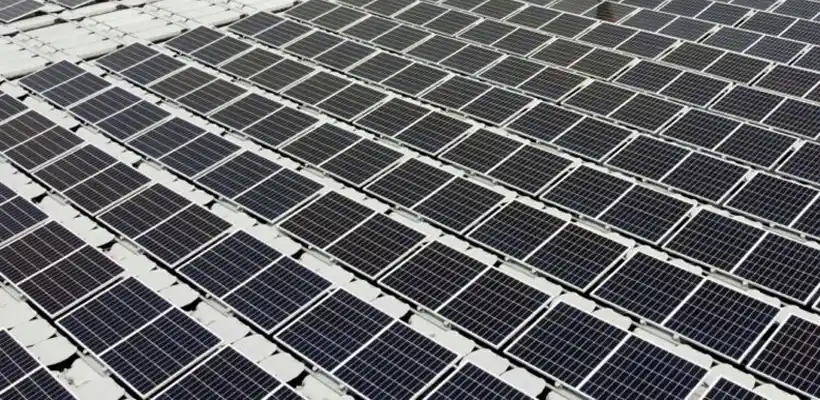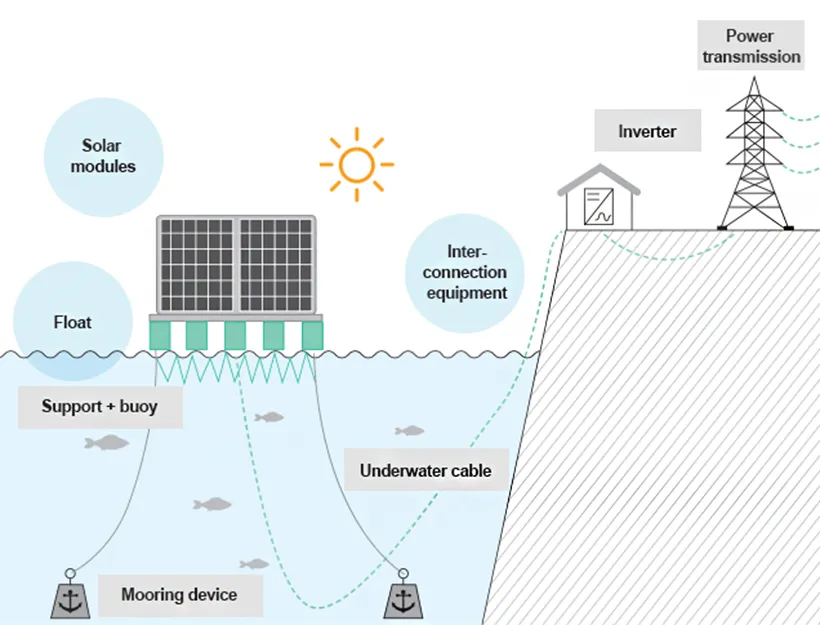- HOME
- ABOUT US
- SOLUTIONS
- Metal Roof PV Mounts and Systems
- Flat Roof Solar Panel Mounting Systems Solutions
- Tile Roof Solar Mounting Systems Solutions
- Solar Tracking Solutions for Commercial PV Projects
- Ground Solar Mounting Systems Solutions
- Floating Solar Solutions - PV Systems
- PV Solar Carport Mounting Systems Solutions
- Balcony Solar Panel Mounting Systems Solutions
- PRODUCTS
- PROJECTS
- COMPANY NEWS
- BLOG
- Contact Us

Not all rooftops are apt for solar panel installation due to concerns like shading, obstructions, the roof's age, and limited space, often leading property owners to explore alternative sites for installation. Unlike traditional solar setups, floating solar installations are positioned over bodies of water, eliminating the need for terrestrial space. These installations employ specialized technologies to stay afloat.
What Is a Floating PV?
This eco-friendly approach to electricity generation melds marine and renewable energy technologies. Solar modules are designed to float on water surfaces like dams or reservoirs, with electricity conveyed through underwater cables to a transmission tower. These panels are crafted to be dustproof, lead-free, highly resistant to humidity, and well-guarded against water ingress.
Floating photovoltaic (PV) systems share much in common with their land-based counterparts, with the key distinction being their placement atop water bodies, thereby bypassing the need for land. Often, even in expansive countries with abundant land, the areas near key energy consumers such as cities and industrial zones may have no available land or the costs might be prohibitive. In such scenarios, floating PV systems present an appealing solution since they aren’t bound by land availability. Particularly in places where land constraints impede energy generation, floating solar installations offer a forward-looking avenue for power production.
Benefits of Floating Solar Power Plants
1. Optimal Land Conservation
Ground-mounted solar panels often necessitate the dedication of valuable land resources. In contrast, floating photovoltaics present a solution that demands no land space, rendering them an ideal choice for deployment on unused water areas like wastewater treatment facilities, drinking water reservoirs, or reservoirs of hydroelectric dams. This approach frees up land, which might have been occupied by solar installations, for alternative uses. Moreover, situating solar panels on water bodies obviates the need for tree clearance, thereby preserving the natural habitat.
2. Capitalizing on Idle Water Surfaces
Floating photovoltaics are widely used in various bodies of water, including wastewater treatment plants, drinking water reservoirs, or hydroelectric dam reservoirs. These installations augment the utility of such spaces while mitigating adverse effects on pond or lake ecosystems. The choice of constructing on man-made water bodies also brings along the advantage of easy integration with existing power plants, fostering simplicity and synergy.
3. Benefits the Environment
The water's cooling effect enhances the performance of the PV modules, while also curbing evaporation from these water bodies— a crucial factor in drought-prone regions.
Moreover, the presence of solar panels on water surfaces diminishes the occurrence of algae blooms in freshwater bodies, which could otherwise lead to health issues when found in drinking water sources or result in the demise of aquatic flora and fauna.
Harnessing clean energy from floating solar panels aids in diminishing reliance on fossil-fuel generated electricity, consequently reducing greenhouse gas emissions.
4. Enhanced Solar Panel Efficiency
Although solar panels exhibit good performance even under elevated temperatures, their efficiency tends to diminish over time. The escalating temperatures inversely affect their efficiency. However, situating PV modules on water bodies allows the water to act as a coolant, thereby boosting their efficiency.
Design Considerations for Floating Solar Power Plants

Source: K-Water.
Anchoring and Mooring System: In a floating PV power plant, a mooring system is indispensable to manage fluctuating water levels, secure the module at a specific location, ensure that the floating solar arrays remain within a reasonable distance from a desired location (station-keeping), and mitigate the displacement of solar arrays engendered by environmental forces like winds, waves, and currents.
Mooring Design: The precision of raw environmental data for the site is pivotal when determining the design specifications for the mooring system. For instance, there's a risk that numerous components, including float attachments, interconnections, mooring lines, and anchors, may deteriorate over time if the design accounts for a maximum wind speed of 30 m/s, while the actual maximum wind speed reaches 40 m/s.
Anchoring Design: The design of the anchoring system typically includes aluminum spreader bars, which facilitate the attachment of mooring lines to the island and distribute the weight across the floats' two connecting tabs. Cables, sized appropriately to account for variations in water level, are employed to link anchors and spreader bars. At the cable ends, adjustable length chains are incorporated to cater to any changes in length. The primary and secondary rows of floats are deployed to sustain buoyancy during strong winds, even in the absence of the PV panel. Anchors, securing the island to the seabed or coastlines, curtail its movement on the water's surface and counter wind loads. Collectively, these elements forge a stable anchoring system.
Pontoon/Floating Structure: The floating assembly for affixing solar panels comprises High Density Polyethylene (HDPE) floaters, which need to pass a range of rigorous tests including the Hunt sealability test, ageing test, Ultra Violet test, the Technischer Überwachungsverein (TUV) wind tunnel test, among others. The inclusion of aluminum alloy clamps simplifies the attachment of solar modules to the main floaters, translating to labor time and cost savings. Moreover, with a service lifespan of 25 years, these floaters present a compelling investment for those seeking a long-term resolution.
Primary Floaters Design Elements: The material chosen for the primary floaters must satisfy several criteria. Foremost, it should be entirely recyclable and non-toxic. It ought to exhibit resistance to UV radiation, alkalis, and saltwater, ensuring its durability. Adaptability to fluctuations in reservoir water levels is crucial, facilitating easy adjustments as required. Moreover, the material should be entirely recyclable. The constructed structures should be capable of enduring extreme temperature fluctuations, spanning from -60°C to 80°C. Lastly, it is crucial that the material boasts a long lifespan, ideally a 25-year underwater endurance capacity.
Installation of Inverters: In a manner akin to standard solar power plants, combiner boxes are employed to channel the DC power generated by solar PV modules to the inverter, where it is converted to AC power. Developers have the latitude to utilize central inverters or multiple string inverters. Depending on the scale of the setup and its proximity to the shoreline, inverters can be stationed on a distinct floating platform or on terra firma. For floating solar systems of lesser capacities, inverters are typically situated on land near the solar arrays, although this is not the case for larger-scale setups.
Cabling: The task of cable management and routing in floating PV plants necessitates careful planning. Unlike their ground-based counterparts, floating solar systems encounter variable cable lengths owing to the motion of the floating platform upon the water's surface, propelled by wind loads and water level alterations. To cater to the movement of the floating platform, provision for additional cable length, in the form of slack, is imperative. Overlooking this aspect could lead to insufficient cable length, posing a risk of cables snapping under tension. Beyond length, the determination of cable size also hinges on the cable's voltage, current, and loss parameters.
Why Does Floating PV Make Sense?
The case for floating solar systems is compelling, particularly in regions where land is scarce. Contrary to common assumptions, floating PVs tend to exhibit higher efficiency. In simple terms, a like-for-like installation—same number of solar panels—when situated on a water body, is capable of generating more energy. This enhanced performance is attributed to the cooling effect provided by the water below.
A well-established fact in solar technology is the inverse relationship between module temperature and efficiency: as solar radiation intensifies, module temperature climbs, which, in turn, diminishes the efficiency. In conventional setups, increased radiation translates to a drop in plant efficiency. However, with floating PV, the water beneath the panels helps maintain a steadier temperature, as it dissipates the heat. Numerous studies assert that such thermal regulation can potentially boost energy generation by up to 12%. It is imperative, however, to assess how this thermal interplay might affect the aquatic flora and fauna before any broad-scale implementation.
Furthermore, floating PVs offer the advantage of mitigating evaporation rates. Assessments of evaporation rates from assorted water bodies reveal higher-than-expected levels. Water sources like lakes, dams, and canals are prone to evaporation, a challenge that floating PVs can address effectively. By curtailing evaporation, floating PV systems contribute to significant water conservation.
Drawing from these insights, it's reasonable to champion the adoption of floating PV systems, provided a thorough examination of their potential impact on the local ecosystem is conducted beforehand.
What Challenges Confront Floating PV Installations?
1. Installation Costs: Currently, the costs of installing floating PV systems are higher compared to traditional on-land installations. This is primarily because these systems require a floating framework and additional provisions for anchoring. However, industry experts predict that as floating PV systems gain popularity and are implemented on a larger scale, the costs are expected to become more competitive. In fact, it is anticipated that manufacturers will benefit from economies of scale, resulting in costs that are on par with, or possibly even lower than, on-land installations.
2. Corrosion and Associated Challenges: Being sited on water, these installations are more susceptible to corrosion and resultant damages. Water bodies typically foster humid conditions, necessitating materials that can endure such environments. This not only pertains to metal components but extends to wires, adhesives, and sealants, which must also exhibit resilience against these conditions. The challenge amplifies when considering installations in saltwater bodies like oceans, due to their highly corrosive nature.
3. Potable Water Safety: Many water bodies under discussion serve as drinking water sources. Hence, materials employed in constructing the PV panels and floating apparatus must be non-contaminating. Any oversight in this regard could bear severe consequences. This scenario also underscores the need for developing new standards and testing methodologies to ensure the safety and efficacy of floating PV installations in such contexts.
Frequently Asked Questions
What Are the Advantages of Floating Solar Panels?
Floating solar panels bring forth several benefits, including minimized shading on the water surface, curtailed water evaporation, and a reduction in algae proliferation in freshwater bodies. These advantages not only contribute to better environmental stewardship but also to the improved performance and longevity of solar installations.
What Are the Challenges Confronting Floating Solar?
The infrastructure of floating solar arrays can be vulnerable to various environmental adversities, potentially impacting their long-term efficacy. These include fluctuations in water levels, harsh storm conditions, earthquakes, and tsunamis. The magnitude of such risks may vary based on geographical and climatic factors, underscoring the importance of thorough site assessments before installation.
How Effective Are Floating Solar Panels?
In regions grappling with severe drought, floatovoltaics could offer a twofold solution. They help conserve water by reducing evaporation, while the water, in turn, cools the solar panels, enhancing their efficiency. Studies suggest that floatovoltaics can achieve up to 15 percent higher efficiency compared to their land-based counterparts, especially as they tend to overheat less, thus requiring less maintenance.

